South India, the cradle of Dravidian architecture and spiritual heritage, is home to some of the most ancient and revered temples in the world. These temples are not just places of worship but also architectural marvels, repositories of history, and centers of cultural richness. Whether you are a pilgrim or a traveler, here’s a curated list of the top 10 temples in South India that you must visit at least once in your lifetime.
1. Meenakshi Amman Temple – Madurai, Tamil Nadu
- Location: Madurai, Tamil Nadu
- Deity: Goddess Meenakshi (a form of Parvati) and Lord Sundareswarar (Shiva)
- Age: Over 2,500 years old (rebuilt in 12th–17th century)
- Significance: One of the most iconic temples in India, known for its stunning Dravidian architecture, towering gopurams, and intricate sculptures.
- Best Time to Visit: October to March
- Special Occasions: Meenakshi Tirukalyanam during Chithirai Festival (April) attracts millions of devotees.
- Famous For: The 14 gopurams (gateway towers), thousand-pillar hall, and the celestial wedding of Meenakshi and Sundareswarar.

2. Tirumala Venkateswara Temple – Tirupati, Andhra Pradesh
- Location: Tirumala Hills, Chittoor District, Andhra Pradesh
- Deity: Lord Venkateswara (an incarnation of Vishnu)
- Age: Believed to be over 1,200 years old
- Significance: One of the richest and most visited temples in the world. Also known as the Balaji Temple.
- Best Time to Visit: September to February
- Special Occasions: Brahmotsavam (September–October), an annual festival that attracts over a million devotees.
- Famous For: The laddu prasadam, hair offering ritual, and spiritual grandeur.
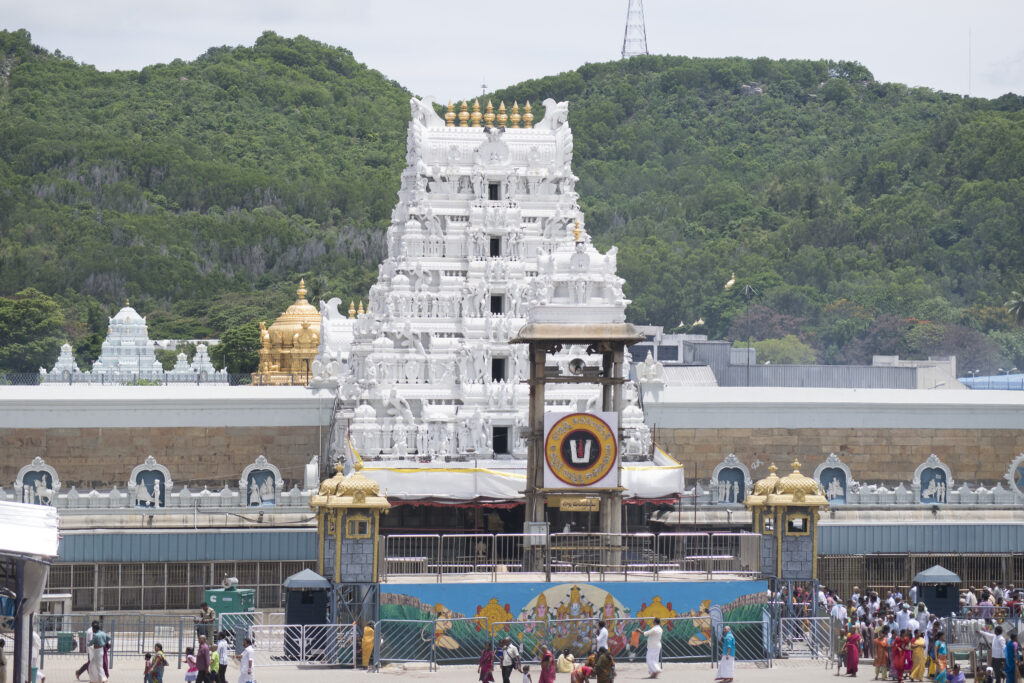
3. Brihadeeswarar Temple – Thanjavur, Tamil Nadu
- Location: Thanjavur, Tamil Nadu
- Deity: Lord Shiva
- Age: Built in 1010 AD by Raja Raja Chola I
- Significance: A UNESCO World Heritage Site, part of the “Great Living Chola Temples.” Known for its engineering marvel and towering vimana (temple tower).
- Best Time to Visit: November to February
- Special Occasions: Maha Shivaratri, Navaratri
- Famous For: 216-feet tall vimana, frescoes, massive Nandi statue, and Chola architecture.

4. Ramanathaswamy Temple – Rameswaram, Tamil Nadu
- Location: Rameswaram Island, Tamil Nadu
- Deity: Lord Shiva
- Age: Dates back to the 12th century; associated with Ramayana era
- Significance: One of the Char Dham pilgrimage sites. It is believed that Lord Rama worshipped Shiva here before crossing to Lanka.
- Best Time to Visit: October to April
- Special Occasions: Maha Shivaratri, Thai Amavasya
- Famous For: Longest temple corridor in India (1,200 meters), sacred wells (22 tirthas), and spiritual sanctity.
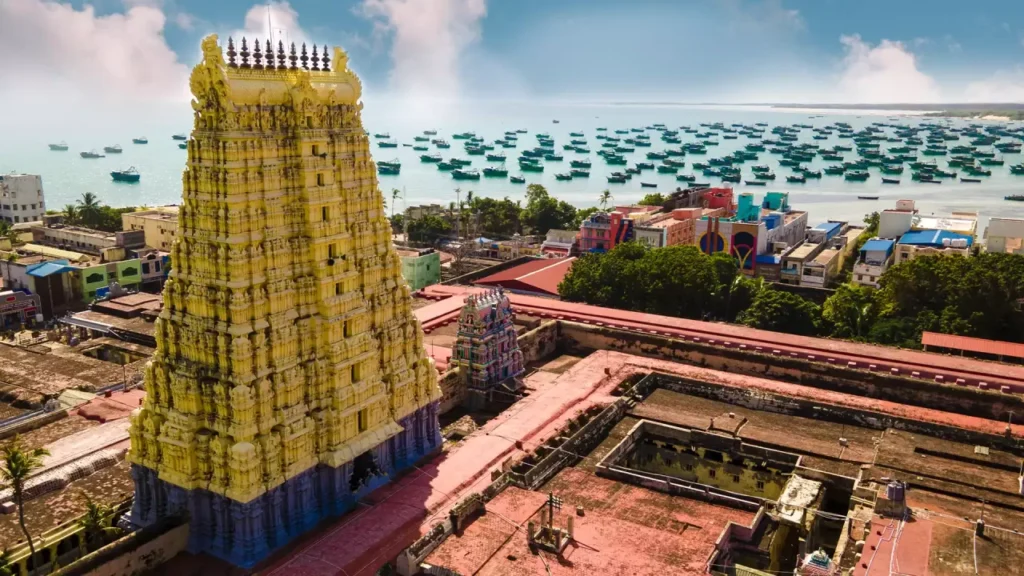
5. Virupaksha Temple – Hampi, Karnataka
- Location: Hampi, Karnataka
- Deity: Lord Virupaksha (form of Shiva)
- Age: Over 1,300 years old (developed significantly under Vijayanagara Empire in the 14th century)
- Significance: UNESCO World Heritage Site; spiritual heart of the once-glorious Vijayanagara capital.
- Best Time to Visit: October to February
- Special Occasions: Chariot Festival in February, Maha Shivaratri
- Famous For: 49-meter-high gopuram, murals, and association with ancient Hampi ruins.
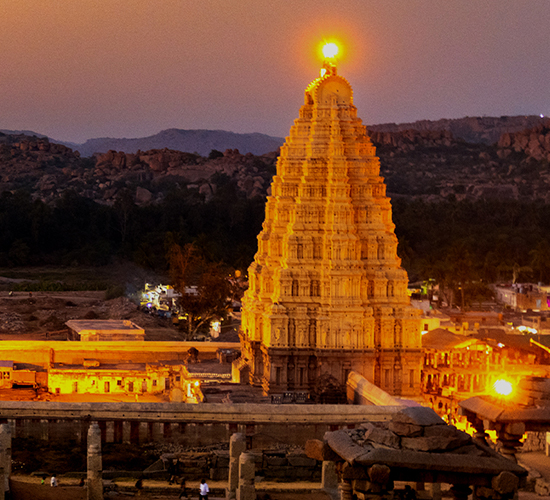
6. Srirangam Ranganathaswamy Temple – Tiruchirappalli, Tamil Nadu
- Location: Srirangam, Tiruchirappalli, Tamil Nadu
- Deity: Lord Ranganatha (resting form of Vishnu)
- Age: Origins in 1st century CE; current structure from the 10th century
- Significance: Largest functioning Hindu temple in the world by area. One of the 108 Divya Desams.
- Best Time to Visit: November to March
- Special Occasions: Vaikunta Ekadasi, Panguni Uthiram
- Famous For: 21 intricately carved gopurams, religious festivals, and spiritual significance for Vaishnavites.
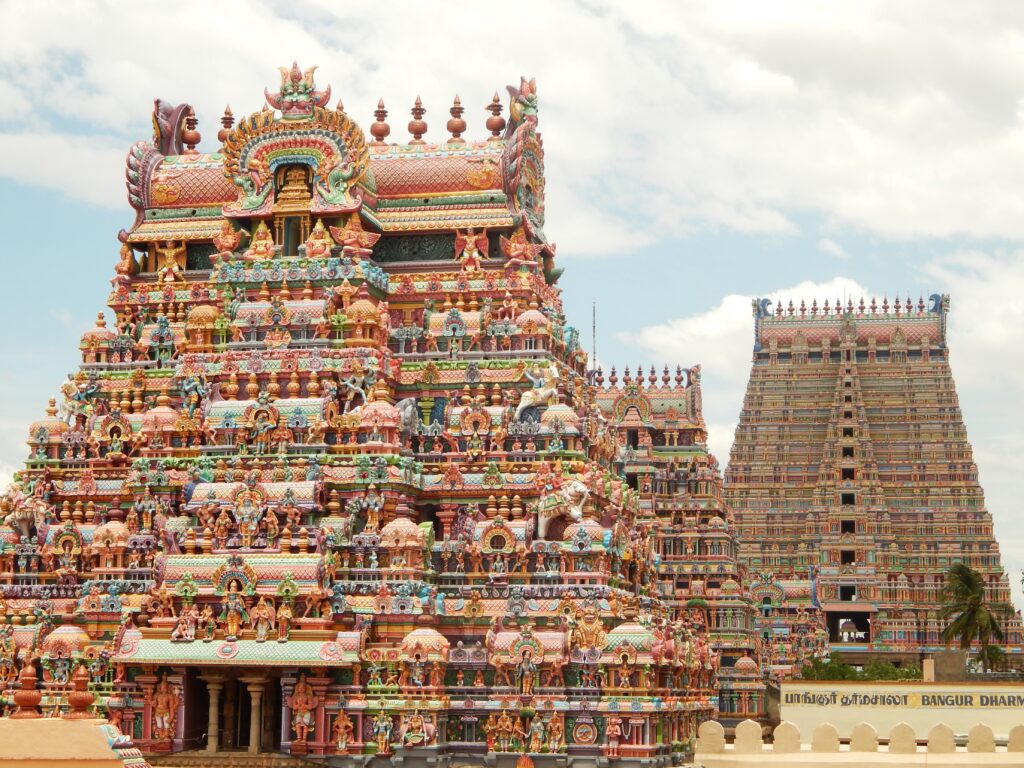
7. Padmanabhaswamy Temple – Thiruvananthapuram, Kerala
- Location: Thiruvananthapuram, Kerala
- Deity: Lord Vishnu in Anantha Shayana posture
- Age: Existence traced back to the 8th century; present structure from 18th century
- Significance: One of the richest temples in the world; associated with Travancore Royal Family.
- Best Time to Visit: October to February
- Special Occasions: Alpashy Festival (Oct–Nov), Painkuni Festival (March–April)
- Famous For: Golden idol, hidden treasures, unique reclining deity, strict dress code.
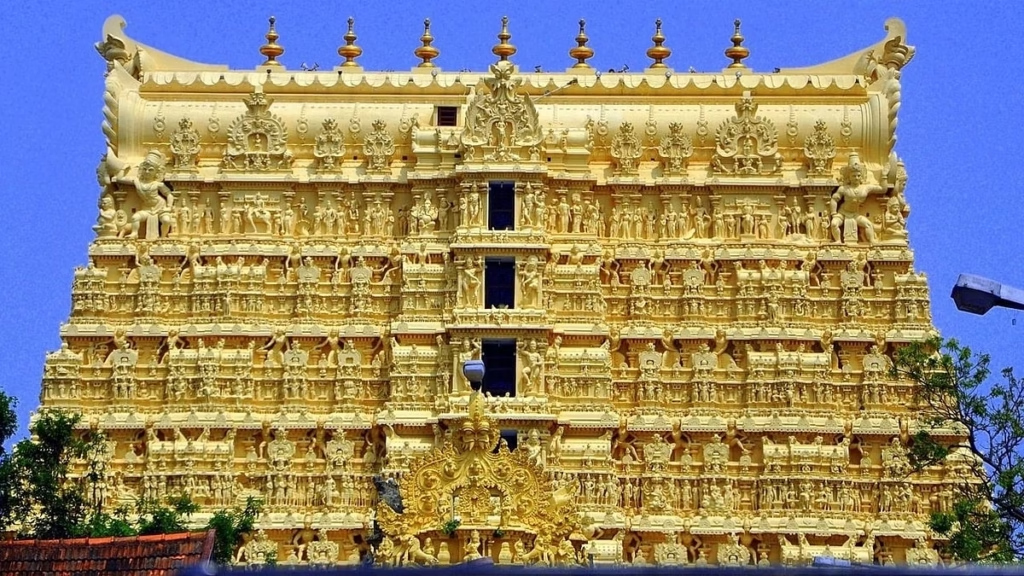
8. Murudeshwar Temple – Uttara Kannada, Karnataka
- Location: Murudeshwar, Karnataka (coastal town)
- Deity: Lord Shiva
- Age: Rebuilt in the 20th century; ancient origins tied to Ramayana
- Significance: Home to the second-tallest Shiva statue in the world (123 ft).
- Best Time to Visit: November to February
- Special Occasions: Maha Shivaratri
- Famous For: Ocean-side temple, 20-storied gopuram with elevator, majestic Shiva statue.

9. Aihole-Durga Temple – Bagalkot, Karnataka
- Location: Aihole, Karnataka
- Deity: Goddess Durga
- Age: Built between the 7th and 8th centuries by Chalukyas
- Significance: One of the earliest known experiments in temple architecture, showcasing a blend of Buddhist and Hindu styles.
- Best Time to Visit: November to February
- Special Occasions: Navratri, local festivals
- Famous For: Unusual apsidal (semi-circular) shape, historical importance in architectural evolution.
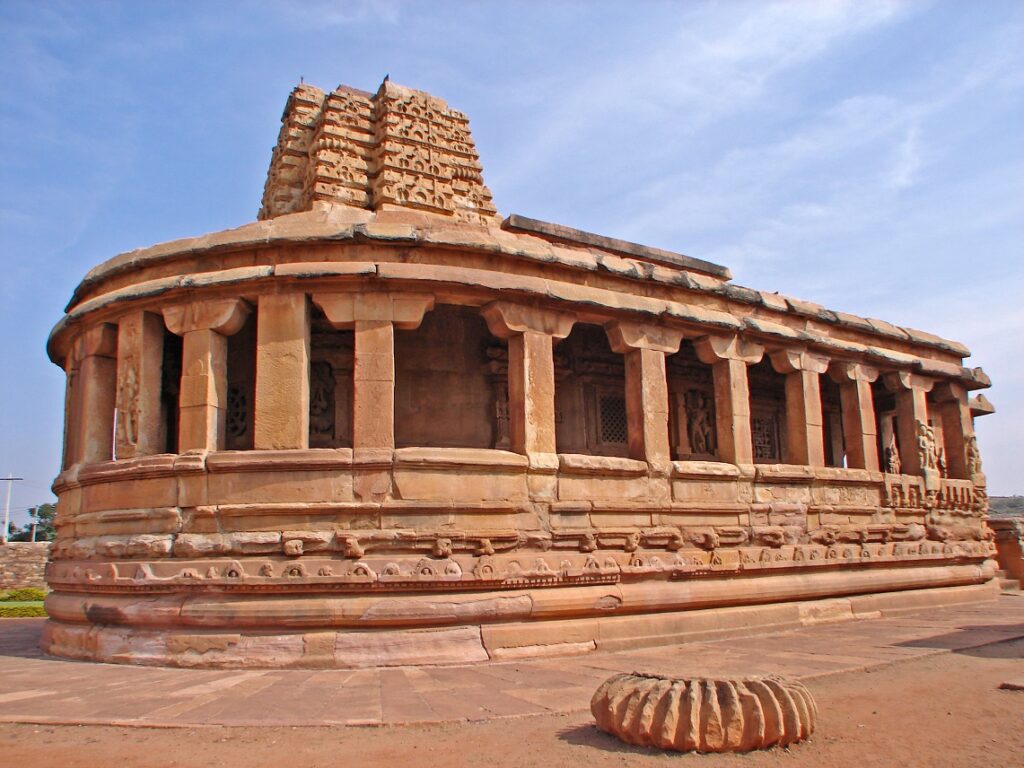
10. Suchindram Thanumalayan Temple – Kanyakumari, Tamil Nadu
- Location: Suchindram, near Kanyakumari
- Deity: Trimurti – Brahma, Vishnu, and Shiva (as Thanumalayan)
- Age: Believed to be over 1,000 years old
- Significance: One of the rare temples dedicated to the Trimurti (three gods in one deity)
- Best Time to Visit: October to March
- Special Occasions: Car Festival, Navaratri
- Famous For: 18-feet high Hanuman statue, musical pillars, and unique combination of divine energies.

Honorable Mentions:
- Ekambareswarar Temple, Kanchipuram – A Pancha Bhoota Sthala representing Earth.
- Chennakesava Temple, Belur – For intricate Hoysala sculpture.
- Kapaleeshwarar Temple, Chennai – A bustling city temple with rich history.
Final Thoughts
South India’s temples are not just sacred spaces—they are living testimonies of devotion, culture, art, and spiritual evolution. Whether you’re on a religious quest or an architectural journey, these temples offer a transformative experience that words often fail to express.
Pro Tips for Visiting Temples in South India:
- Dress modestly: Many temples enforce a traditional dress code.
- Respect customs: Some temples restrict non-Hindus or photography inside sanctum areas.
- Visit early mornings: To avoid crowds and feel the spiritual ambiance.
- Festival Times: Offer a grand spectacle but can get very crowded.
If you’re planning a spiritual tour, these ten temples should definitely be on your bucket list. From mystical stories to architectural wonders, each temple offers a unique experience that leaves a lasting impact on the soul.
Frequently Asked Questions (FAQs)
1. Which is the oldest temple in South India?
The Brihadeeswarar Temple in Thanjavur, built in 1010 AD by Raja Raja Chola I, is one of the oldest and most architecturally significant temples in South India. However, many temples like Meenakshi Temple and Virupaksha Temple have origins dating back over 2,000 years.
2. Which is the richest temple in South India?
The Tirumala Venkateswara Temple in Tirupati, Andhra Pradesh, is not only the richest temple in South India but also among the wealthiest religious institutions globally, thanks to millions of devotees and massive donations.
3. What is the best time to visit temples in South India?
The ideal time to visit most South Indian temples is from October to March, when the weather is pleasant. Major festivals like Pongal, Brahmotsavam, Navaratri, and Maha Shivaratri are celebrated during these months with grandeur.
4. Are non-Hindus allowed in temples in South India?
While many temples welcome all visitors, some like Padmanabhaswamy Temple and Guruvayur Temple restrict entry strictly to Hindus. It’s advisable to check temple rules beforehand.
5. Is there a dress code for visiting temples in South India?
Yes, most temples require traditional attire. For men, dhoti or long pants and shirt; for women, saree, salwar kameez, or long skirts are preferred. Shorts, sleeveless tops, and Western outfits may not be allowed.
6. Which temple has the longest corridor in India?
The Ramanathaswamy Temple in Rameswaram has the longest corridor in any Hindu temple in India, stretching over 1,200 meters with over 1,000 intricately carved pillars.
7. Are photography and videography allowed inside temples in South India?
Photography rules vary by temple. While external photography is usually permitted, inner sanctum areas (garbhagriha) typically restrict photography. Always follow signage and ask permission if unsure.
8. How can I plan a tour of temples in South India?
You can plan a 10–15 day itinerary covering Tamil Nadu (Madurai, Rameswaram, Thanjavur), Karnataka (Hampi, Murudeshwar), Kerala (Padmanabhaswamy), and Andhra Pradesh (Tirupati). Many travel agencies offer guided spiritual tours.
9. Are there any UNESCO World Heritage Temples in South India?
Yes, the Brihadeeswarar Temple (Thanjavur), Gangaikonda Cholapuram, Airavatesvara Temple, and Virupaksha Temple (Hampi) are part of UNESCO’s World Heritage Sites list due to their historical and architectural value.
10. Why are temples in South India known for their gopurams?
South Indian temples follow Dravidian architecture, known for their towering gateway structures called gopurams, adorned with vibrant sculptures of gods, demons, and celestial beings, making them architectural landmarks.
For more such detailes about South of India please visit Karnataka Tourism, Tamilnadu Tourism , Kerala Tourism, Telengana Tourism or Andhra Pradesh Tourism Websites.
Read complete guide about Char Dham Yatra, Types and Benefits of Rudraksha, 13 Jyotirlingas of Lord Shiva under spritual and wellness of Popnewsblend.

Hi, I’m Prashant Jain — a curious soul, storyteller, and content creator at heart.I’ve always been drawn to the world of entertainment, travel, sports, health & lifestyle — not just as a writer, but as someone who genuinely lives these experiences. Whether I’m binge-watching the latest OTT series, exploring offbeat spiritual destinations in India, or diving deep into wellness routines and cricket match insights, I love sharing what I discover with like-minded readers.
PopNewsBlend is my way of blending personal journeys with meaningful stories — ones that inform, inspire, and keep you ahead of the curve. Everything I write comes from real observations, hands-on experiences, and a deep passion for understanding the world around us.
Discover more from Popnewsblend
Subscribe to get the latest posts sent to your email.

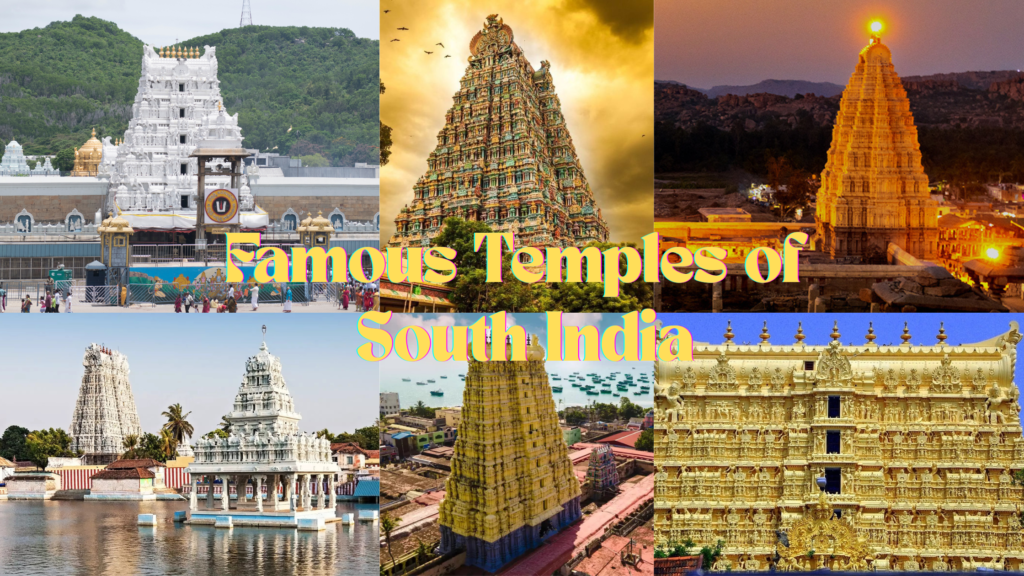






Pingback: Top 15 Spiritual Places in India Every Hindu Must Visit
Pingback: 10 Hidden Travel Gems in South India You Must Visit in 2025